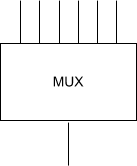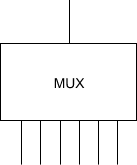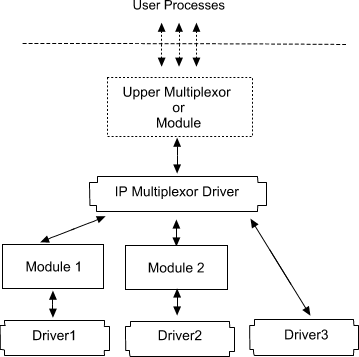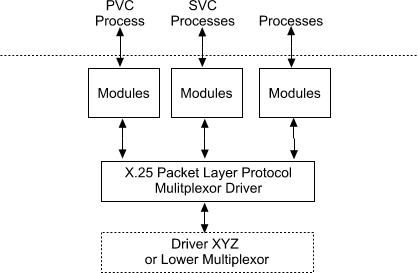
|
|
A STREAMS multiplexor is a driver with multiple STREAMS connected to it. The primary function of the multiplexing driver is to switch messages among the connected Streams. Multiplexing is used to implement terminal window facilities, and internetworking protocols which might route data over several subnetworks.
The following illustration shows an example of a multiplexor that multiplexes data from several upper Streams over a single lower Stream. An upper Stream is one that is upstream from a multiplexor, and a lower Stream is one that is downstream from a multiplexor. A terminal windowing facility might be implemented in this fashion, where each upper Stream is associated with a separate window.

Many-to-One multiplexor
The following illustration shows a second type of multiplexor that might route data from a single upper Stream to one of several lower Streams. An internetworking protocol could take this form, where each lower Stream links the protocol to a different physical network.

One-to-Many multiplexor
The following illustration shows a third type of multiplexor that might route data from one of many upper Streams to one of many lower Streams.

Many-to-Many multiplexor
The STREAMS mechanism supports the multiplexing of Streams through special pseudo-device drivers. Using a linking facility, users can dynamically build, maintain, and dismantle multiplexed Stream configurations. Simple configurations like the ones shown in the previous illustrations can be further combined to form complex, multilevel multiplexed Stream configurations.
STREAMS multiplexing configurations are created in the kernel by interconnecting multiple Streams. Conceptually, there are two kinds of multiplexors: upper and lower multiplexors. Lower multiplexors have multiple lower Streams between device drivers and the multiplexor, and upper multiplexors have multiple upper Streams between user processes and the multiplexor.
The following illustration is an example of the multiplexor configuration that typically occurs where internetworking functions are included in the system. This configuration contains three hardware device drivers. The IP (Internet Protocol) is a multiplexor.
The IP multiplexor switches messages among the lower Streams or sends them upstream to user processes in the system. In this example, the multiplexor expects to see the same interface downstream to Module 1, Module 2, and Driver 3.

Internet multiplexing stream
The previous illustration depicts the IP multiplexor as part of a larger configuration. The multiplexor configuration, shown in the dashed rectangle, generally has an upper multiplexor and additional modules. Multiplexors can also be cascaded below the IP multiplexor driver if the device drivers are replaced by multiplexor drivers.
The following illustration shows a multiplexor configuration where the multiplexor (or multiplexing driver) routes messages between the lower Stream and one upper Stream. This Stream performs X.25 multiplexing to multiple independent Switched Virtual Circuit (SVC) and Permanent Virtual Circuit (PVC) user processes. Upper multiplexors are a specific application of standard STREAMS facilities that support multiple minor devices in a device driver. This figure also shows that more complex configurations can be built by having one or more multiplexed drivers below and multiple modules above an upper multiplexor.
Developers can choose either upper or lower multiplexing, or both, when designing their applications. For example, a window multiplexor would have a configuration similar to the X.25 configuration of the following illustration, with a window driver replacing the Packet Layer, a tty driver replacing the driver XYZ, and the child processes of the terminal process replacing the user processes. Although the X.25 and window multiplexing Streams have similar configurations, their multiplexor drivers would differ significantly. The IP multiplexor in the previous illustration has a different configuration than the X.25 multiplexor, and the driver would implement its own set of processing and routing requirements in each configuration.

X.25 multiplexing stream
In addition to upper and lower multiplexors, you can create more complex configurations by connecting Streams containing multiplexors to other multiplexor drivers. With such a diversity of needs for multiplexors, it is not possible to provide general purpose multiplexor drivers. Instead, STREAMS provides a general purpose multiplexing facility, which allows users to set up the intermodule/driver plumbing to create multiplexor configurations of generally unlimited interconnection.
See ``Uniplexor (UNI multiplexor)'' for information about the UNI multiplexor that is used on SVR5 systems when a driver and module have different levels of ``MP-awareness'' as discussed in ``Multithreaded drivers''.